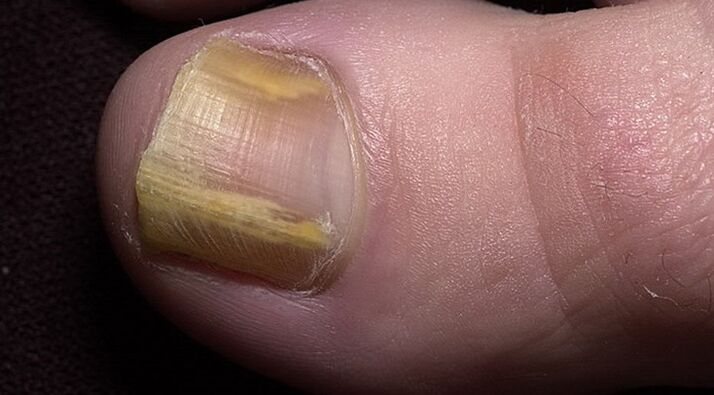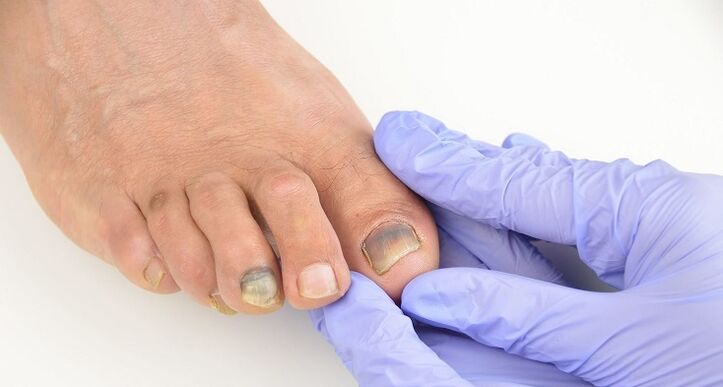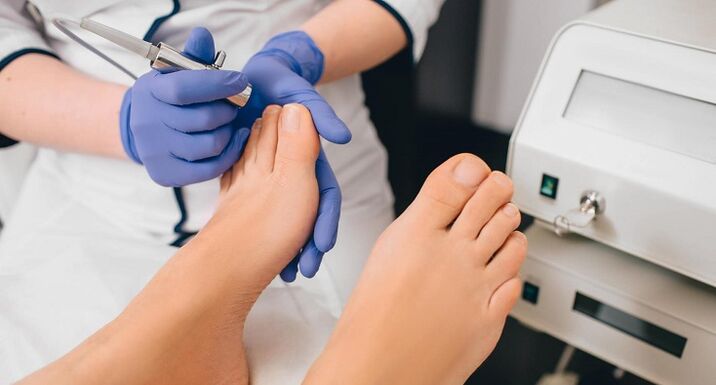Nail fungus is a disease caused by various groups of pathogens. To destroy it, you need to undergo diagnostics to identify all the features of the disease. What is the cause of the incident? There are many reasons for the emergence of fungal infections, prerequisites for its appearance.

The genetic cause of the disease
Fungal spores can be found on a variety of surfaces over the years. One often encounters pathogenic microorganisms, but infections do not always occur. In order for nail fungus to appear, there must be a covering factor. The infection must have a condition to develop. Scientists have done a lot of research on the mechanism of onset of this disease.
It turns out that one of the factors in the emergence of fungal infections is a genetic predisposition. According to research, mycosis most often occurs in people whose relatives have similar conditions. The development of the disease affects the genetic level.
Interesting cases of infection while living together. With close contact, it is easiest to get mycosis. However, it often develops in one household, but does not affect the other. The disease usually appears in people who have genes most similar to people who initially had mycosis. According to all these data, relationship proximity is less important for infection compared to genetic binding relationships.
Symptoms of mycosis
Nail fungus manifests itself in different ways at different levels. Usually, mycosis infection begins with the interdigital space. Currently, there are:
- The appearance of bubbles;
- Redness of the skin;
- Itching.
If treatment is not done at this stage, then the disease begins to attack the nail. In this case, the following symptoms are detected:
- Neatness of the nail plate, loss of transparency by it;
- Appearance of white streaks, spots;
- Uncomfortable sensation.
It is better to carry out treatment at this stage, as this will reduce the cost of therapy. To destroy microorganisms, external preparations will suffice: ointments, varnishes. If you do not take action, nail fungus will grow. This is expressed through the following symptoms:
- Thinning or thickening of nails;
- Exfoliation of nail plates;
- Departing from the nail bed;
- The plate acquires an abnormal color: turns white, yellow or black;
- In the last stage, the nails literally crumble, crumble, and an unpleasant odor may occur.
Mycosis performs its pathological activity not only on the toenails. The inflammatory process takes over the entire leg.
She started squeezing, peeling. The patient feels itching, which increases during the exacerbating period. The presence of special signs allows you to determine the disease at an initial examination.

Types of fungal infections
Nail fungus is divided into types depending on the group of microorganisms it causes. There are three main groups:
- Dermatofit.The most common case. This group is the cause of mycosis in 95% of cases;
- Candida.These yeast -like microorganisms contribute to the thinning of the nail plate. She started to turn yellow and was left behind in her bed. The lesion begins with the folds of the nail. With the progression of the disease, swelling occurs. In some cases, discharge of pus may occur. The skin of the plate stops growing, and therefore turns brown. The nails are broken. This group of microorganisms usually develops in women. There is a risk group - housewives who always deal with household chemicals. It attacks the skin aggressively, which opens a "door" for infection;
- Moldy species.This group of microorganisms cannot penetrate deep into the nail plate. It is not possible to destroy it completely, but the disease is fraught with other effects. Nails change color a lot. It can use black, blue, green.
Treatment is carried out depending on the group of microorganisms, because different pathogenic microbes respond differently to the drug. Sometimes, when diagnosed, three types of fungi are detected. In this case, complex therapy will be required.
Fungal forms
There are various stages of the disease, which differ in the type of lesion:
- Normotrophic.The color of the nail plate changes. It can turn yellow, lose transparency. White and yellow lines or dots appear. The difference between these diseases is that the nails do not undergo significant deformation. Sometimes it is able to retain its former greatness;
- Atropic.The nails become thinner, losing their luster completely. There are clear white and yellow lines, dots that represent the focus of a special infection;
- Hypertrophic.The plate changes significantly. Thickening, signs of collapse were observed. It becomes porous. Significant pain syndrome may also occur, worsening during movement, wearing tight shoes. This disease can limit a person's activity.
The prescribed treatment regimen depends on the level, as well as on the type of microorganism. In the first stage, external agents prove to be effective. At a later stage, the therapy regimen is usually a combination of topical and oral medications.
Where can You Get Fungus?
Nail fungus usually spreads from person to person. Spores of microorganisms can remain on the surface. When you touch it, the fungus will remain on the foot and begin to grow. You can get mycosis in the following places:
- Public institutions: sauna, swimming pool, sports club showers. This is the most likely way to get the fungus, as it actively breeds in hot and humid conditions. To protect it, it is necessary, before going to the institution, to do foot prevention with medications. You must have your own slippers;
- If mycosis occurs in the household, the path that may arise for the onset of the disease in other family members is bathing. Fungal spores remain on its walls, causing mycosis. For protection, it is necessary to treat the surface with a disinfectant after each visit to the bathroom;
- Sometimes the reason is a manicure or pedicure done with an instrument that has not been disinfected after the last use. This refers to procedures performed in a beauty salon;
- Disputes can lurk shoes in the store, as they are often tried on by different people. For protection, you can measure the shoe only at the tip of the foot;
- A less likely source of infection is the general beach, as nail fungus cannot survive well in salty sand.
To prevent disease, one must not forget the importance of personal slippers and use prophylactic methods.

Possible complications with prolonged treatment
For mycosis, the rate of development and spread is characteristic. If you are late for treatment, the symptoms of the disease will become more pronounced. At first, one worries about aesthetic factors, because of the thickening, white dots appear on the toenails. But, if you do not overcome the problem, more serious consequences will arise - pain during movement, itching and burning. Let's consider the possible consequences of prolonged treatment:
- Other infections may occur when the body becomes weak;
- Exacerbation of diabetes mellitus. Occurrence, against the background of infectious processes, gangrene or bone tissue infection. All of these can lead to the need for limb amputation;
- If nail fungus is not treated for a long time, then the body may react to it with hypersensitivity and allergic reactions. Against their background, allergic dermatitis, skin diseases, bronchial asthma worsen;
- Extreme levels of mycosis are damage to internal organs. The infection begins to spread throughout the body. This can be fatal.
Another important consequence of not starting therapy on time is the substantial financial cost. In the latter stage, the disease is not only more difficult to treat, but also more expensive. We must spend money for local procedures, pills. Drugs that are really effective are more expensive. In some cases, surgery may also be prescribed.
Preventive measures
Nail fungus can be prevented, that's what prevention is all about. They allow you to prevent the entry of pathogenic microorganisms and their further spread. Prevention is simple enough, and this includes the following tips:
- Tight shoe removal, improperly chosen last. All this leads to the appearance of corns and other deformities in which the infection enters;
- Avoid wearing synthetic socks and tights as your feet will sweat. Sweat and a humid environment are the best conditions for fungal growth;
- It is necessary to maintain personal hygiene, wear slippers when in indoor public places, perform initial treatment of the feet with prophylactic agents;
- After each foot wash, the interdigital area is thoroughly dried;
- Replacement of socks and stockings must be done daily;
- You can’t wear other people’s shoes;
- The house must be kept clean, for which disinfection is done periodically.
Prevention is aimed at two purposes - preventing infection from entering and stopping its progression if spores get inside. To achieve the second goal, you need to take care of your immune system: play sports, eat right.
Methods of treatment
Nail fungus usually takes a long time to heal. The duration of therapy, regardless of the cause of the disease, is from 6 months to a year. The advantage is that most medications can relieve symptoms quickly. But, despite the disappearance of symptoms, it is still necessary to continue therapy until complete destruction of microorganisms.
For treatment in the early stages, external medications are used. This includes:
- Special varnish;
- Creams and gels;
- Solutions and colors.
At a later stage, oral medications are added to external medications:
- Pil;
- Antibiotics
Varnishes are very popular. They have two effects at once: they destroy existing microorganisms and create a film that prevents the entry of new infections. This tool is able to penetrate deep into the nail. It is colorless and odorless, and therefore can be used by men. It is best to remove the nail plate before use to ensure deeper penetration.

Gentle ointment and gel. They are easy to use. Relieve symptoms quickly. With the help of medicines, you can treat not only the nails, but also the surrounding skin. The disadvantage is that the product can quickly get rid of the skin. To avoid this, compresses can be done: a cotton pad is placed over the ointment layer, fastened with a bandage.
Tablets are prescribed in severe cases. This drug has a strong, toxic effect and has contraindications. For this reason, therapy is performed under the supervision of a physician.
If the case is completely ignored, surgical intervention can be performed. During the operation, the affected nail is removed. Its removal can be done without surgery. For this, special methods are used. The last option does not hurt.
Nail fungus is a very common problem. His ignorance lies in the fact that, in the early stages, the symptoms of the disease are insignificant. The patient can continue to delay treatment, because he does not feel uncomfortable. All this leads to the fact that the problem becomes ignored. To solve it, you need a lot of funds and medicines. Mycosis spreads quickly, leading to pain, plate discharge, unpleasant odors, and nail changes.















